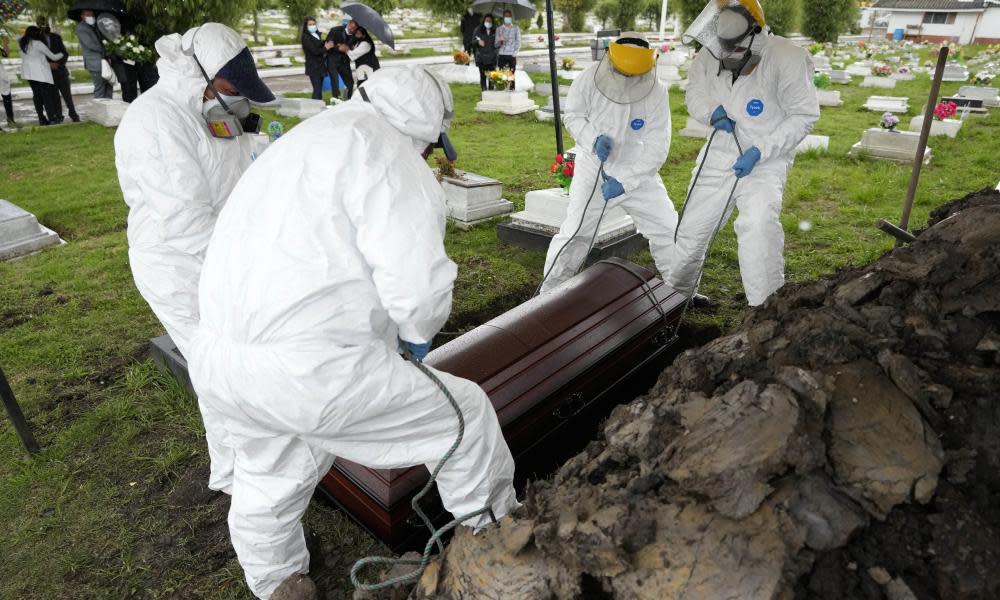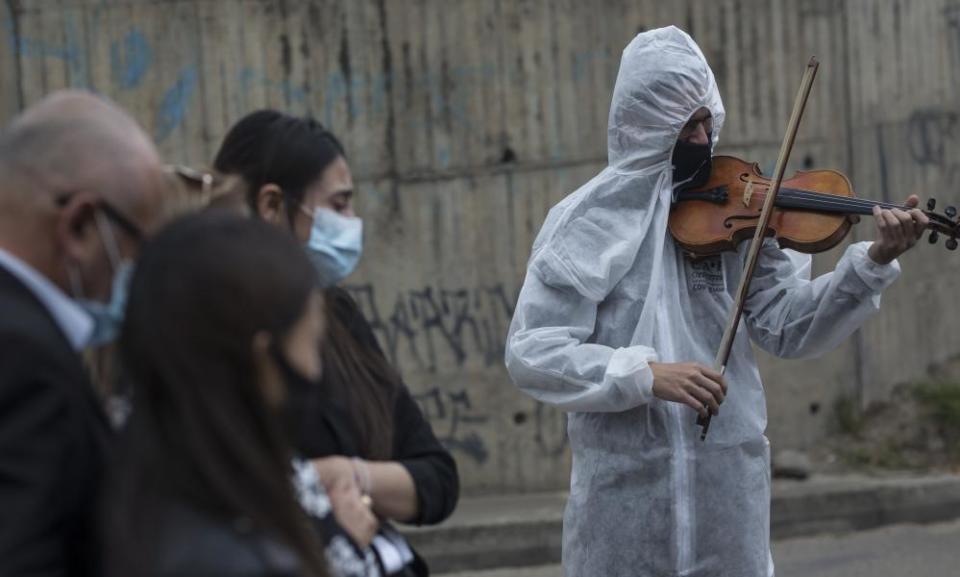‘Everything is collapsing’: Colombia battles third Covid wave amid unrest

Related: ‘This is a revolution’: the faces of Colombia’s protests
Marisol Bejarano, an intensive care unit doctor at El Tunal hospital in the Colombian capital, Bogotá, has watched people die – slowly and far from family – since the pandemic began.
She has been at the frontlines as the disease has ravaged the South American country, taking more than 100,000 lives, and has broken the news to next of kin so many times that she no longer keeps count. But little could have prepared the 28-year-old specialist for what she is now seeing.
“We’ve been training for this since we began our medical training, but the psychological toll of seeing so much death is heavy,” Bejarano said, raising her voice above the cacophony of beeps from the unit’s 14 life support machines. “This is bad.”
Like much of South America, Colombia is being battered by a surging third wave of Covid-19. About 40,000 lives have been lost to the disease since mid-March – about 40% of the total death toll.
More than 25,000 cases are reported each day, with daily average deaths at 590 in the last week. Hospital networks across the country have collapsed, with ICU occupancy in the three largest cities – Bogotá, Medellín and Cali – hovering above 97%.
But unlike its neighbours, Colombia has reached the toughest point in the pandemic as the country is convulsed by unprecedented social upheaval and protests against economic inequality – which has only widened during the pandemic. And now, doctors are seeing worrying new pathologies in the virus’s spread, even as new variants spread.
“The difference now is that more young people are dying,” said Bejarano, adding that most elderly people in Colombia have now been vaccinated, and that the protests are more often attended by younger people. Protest leaders last week announced a temporary pause on mass marches in response to the public health calamity, heeding pleas from officials.
About half of the patients under Bejarano’s care, intubated and unconscious, are younger than 65. Many of them are suffering kidney failure and will probably die hooked up to dialysis machines and mechanical ventilators.
As the fresh-faced doctor and a team of technicians checked on patients, occasionally cracking jokes to lighten the mood, an orderly lugged tanks of oxygen – supplies of which are scarce – into the ICU. One nurse, wiping sweat from her brow, stepped out to visit a vending machine. Another turned a comatose patient on his side and bathed him. “We’re exhausted, we’ve fallen sick, and we’re badly paid,” Bejarano said.
When Covid-19 hit Colombia in March 2020, El Tunal hospital had 32 ICU beds. Now it has 106 and each one is in use. Patients needing a bed have to wait until a current occupant either recovers or dies.
“We could have 1,000 beds here – we could be the biggest hospital in the world – but the situation wouldn’t improve as the rates of contagion are so high,” said Jhon Parra, the doctor in charge of the hospital’s ICUs. “We are scared and we are psychologically and emotionally drained.”
The factors contributing to the current outbreak are myriad.
Vaccination rollout was slow to start and still only 20% of the population have received one dose. Marches and gatherings during the unrest have contributed. Many Colombians, who last year lived through one of the world’s longest lockdowns, are increasingly relaxed about mask use and social distancing.
Meanwhile, President Iván Duque’s government has continued to open up the country, in an effort to stave off further damage to the economy. Since late last year, gyms, restaurants and nightclubs have been open in some cities, with varying caveats. And despite the surge of cases, the country lifted most remaining restrictions on 8 June.
“I understand the need to restart the economy – but you won’t have much of one if everyone is dead,” said Parra, during a rare break in his office. “And reopening the economy gave people a false sense of security, and so they stopped protecting themselves in marches and elsewhere.”
Public health experts have been less diplomatic.
“The response to the pandemic has been a model of catastrophe. It is a scandal,” said Román Vega, a professor of public health at Bogotá’s Javeriana University. “First, we have a surging wave of cases. Second, we have low vaccination rates. Third, we have an ongoing social uprising. Fourth, the government has decided to further open up the economy in spite of all that. Fifth, we have a health system incapable of responding. This is a catastrophe.”
Ronny Suárez, a journalist who has covered the pandemic in Colombia for the newspaper El Tiempo every day since March 2020, went further. “We have to say it very clearly: as a society we have failed ourselves and the victims.”

Earlier this month, Bogotá’s mayor, Claudia López, advised people to avoid showing up at hospitals except in the most severe cases and begged people to avoid in-person marches and protests.
In the car park outside El Tunal hospital, large tents with gurneys and rudimentary supplies have been set up so doctors can treat emergency patients quickly, without admitting them inside the main buildings. Ambulances, some with sirens blaring, queue for a block to drop off patients.
“So far we haven’t had people dying while they wait to be seen, like in Europe when the pandemic started, but that is going to happen here unless people start protecting themselves,” said Daniel Huertas, 34, who runs the accident and emergency ward. “It’s frustrating, to say the very least, to leave work and see people not doing that.
“But this is what we’re dealing with,” the exasperated doctor said. “Everything is collapsing around us.”

